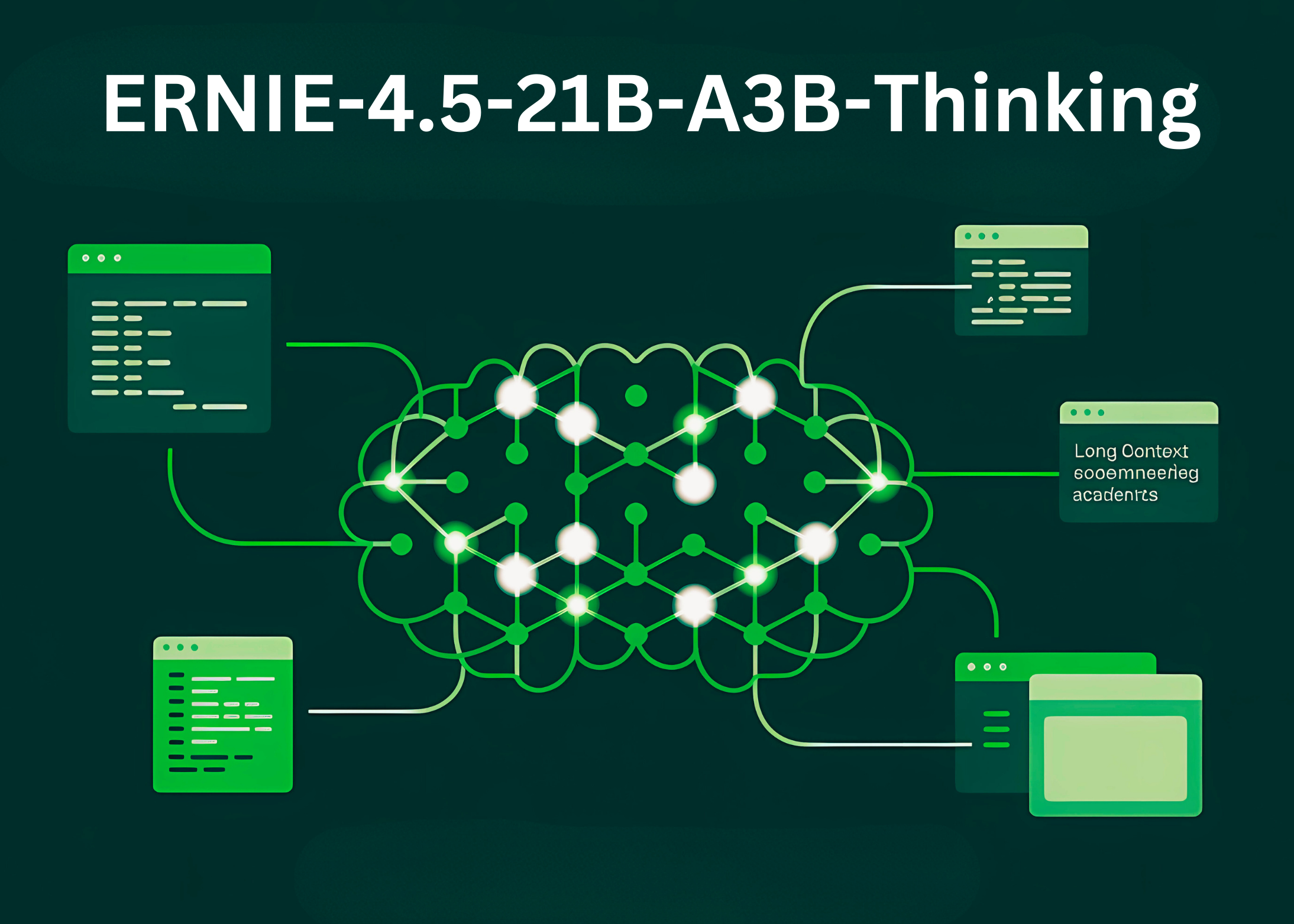Baidu Releases ERNIE-4.5-21B-A3B-Thinking: A Compact MoE Model for Deep Reasoning

Baidu AI Research team has just released ERNIE-4.5-21B-A3B-Thinking, a new reasoning-focused large language model designed around efficiency, long-context reasoning, and tool integration. Being part of the ERNIE-4.5 family, this model is a Mixture-of-Experts (MoE) architecture with 21B total parameters but only 3B active parameters per token, making it computationally efficient while maintaining competitive reasoning capability. Released under the Apache-2.0 license, it is accessible for both research and commercial deployment via Hugging Face.
What is the architectural design of ERNIE-4.5-21B-A3B-Thinking?
ERNIE-4.5-21B-A3B-Thinking is built on a Mixture-of-Experts backbone. Instead of activating all 21B parameters, the router selects a subset of experts, resulting in 3B active parameters per token. This structure reduces computation without compromising the specialization of different experts. The research team applies router orthogonalization loss and token-balanced loss to encourage diverse expert activation and stable training.
This design provides a middle ground between small dense models and ultra-large systems. The research team’s assumptions include a theory that ~3B active parameters per token may represent a practical sweet spot for reasoning performance versus deployment efficiency.
How does the model handle long-context reasoning?
A defining capability of ERNIE-4.5-21B-A3B-Thinking is its 128K context length. This allows the model to process very long documents, perform extended multi-step reasoning, and integrate structured data sources such as academic papers or multi-file codebases.
The research team achieves this through progressive scaling of Rotary Position Embeddings (RoPE)—gradually increasing the frequency base from 10K up to 500K during training. Additional optimizations, including FlashMask attention and memory-efficient scheduling, make these long-context operations computationally feasible.
What training strategy supports its reasoning?
The model follows the multi-stage recipe defined across the ERNIE-4.5 family:
- Stage I – Text-only pretraining builds the core language backbone, starting with 8K context and expanding to 128K.
- Stage II – Vision training is skipped for this text-only variant.
- Stage III – Joint multimodal training is not used here, as A3B-Thinking is purely textual.
Post-training focuses on reasoning tasks. The research team employs Supervised Fine-Tuning (SFT) across mathematics, logic, coding, and science, followed by Progressive Reinforcement Learning (PRL). Reinforcement stages begin with logic, then extend to mathematics and programming, and finally to broader reasoning tasks. This is enhanced by Unified Preference Optimization (UPO), which integrates preference learning with PPO to stabilize alignment and reduce reward hacking.
What role does tool usage play in this model?
ERNIE-4.5-21B-A3B-Thinking supports structured tool and function calling, making it useful for scenarios where external computation or retrieval is required. Developers can integrate it with vLLM, Transformers 4.54+, and FastDeploy. This tool-use capability is particularly suited for program synthesis, symbolic reasoning, and multi-agent workflows.
Built-in function calling allows the model to reason over long contexts while dynamically invoking external APIs, a key requirement for applied reasoning in enterprise systems.
How does ERNIE-4.5-21B-A3B-Thinking perform on reasoning benchmarks?
It show strong performance improvements across logical reasoning, mathematics, scientific QA, and programming tasks. In evaluations, the model demonstrates:
- Enhanced accuracy in multi-step reasoning datasets, where long chains of thought are required.
- Competitiveness with larger dense models on STEM reasoning tasks.
- Stable text generation and academic synthesis performance, benefiting from extended context training.
These results suggest that the MoE structure amplifies reasoning specialization, making it efficient without requiring trillion-scale dense parameters.

How does it compare to other reasoning-focused LLMs?
This release gets into the landscape that includes OpenAI’s o3, Anthropic’s Claude 4, DeepSeek-R1, and Qwen-3. Many of these competitors rely on dense architectures or larger active parameter counts. Baidu research team’s choice of a compact MoE with 3B active parameters offers a different balance:
- Scalability: Sparse activation reduces compute overhead while scaling expert capacity.
- Long-context readiness: 128K context is directly trained, not retrofitted.
- Commercial openness: Apache-2.0 license lowers adoption friction for enterprises.
Summary
ERNIE-4.5-21B-A3B-Thinking explains how deep reasoning can be achieved without massive dense parameter counts. By combining efficient MoE routing, 128K context training, and tool integration, Baidu’s research team offers a model that balances research-grade reasoning with deployment feasibility.
Check out the Model on Hugging Face and PAPER. Feel free to check out our GitHub Page for Tutorials, Codes and Notebooks. Also, feel free to follow us on Twitter and don’t forget to join our 100k+ ML SubReddit and Subscribe to our Newsletter.
Asif Razzaq is the CEO of Marktechpost Media Inc.. As a visionary entrepreneur and engineer, Asif is committed to harnessing the potential of Artificial Intelligence for social good. His most recent endeavor is the launch of an Artificial Intelligence Media Platform, Marktechpost, which stands out for its in-depth coverage of machine learning and deep learning news that is both technically sound and easily understandable by a wide audience. The platform boasts of over 2 million monthly views, illustrating its popularity among audiences.



